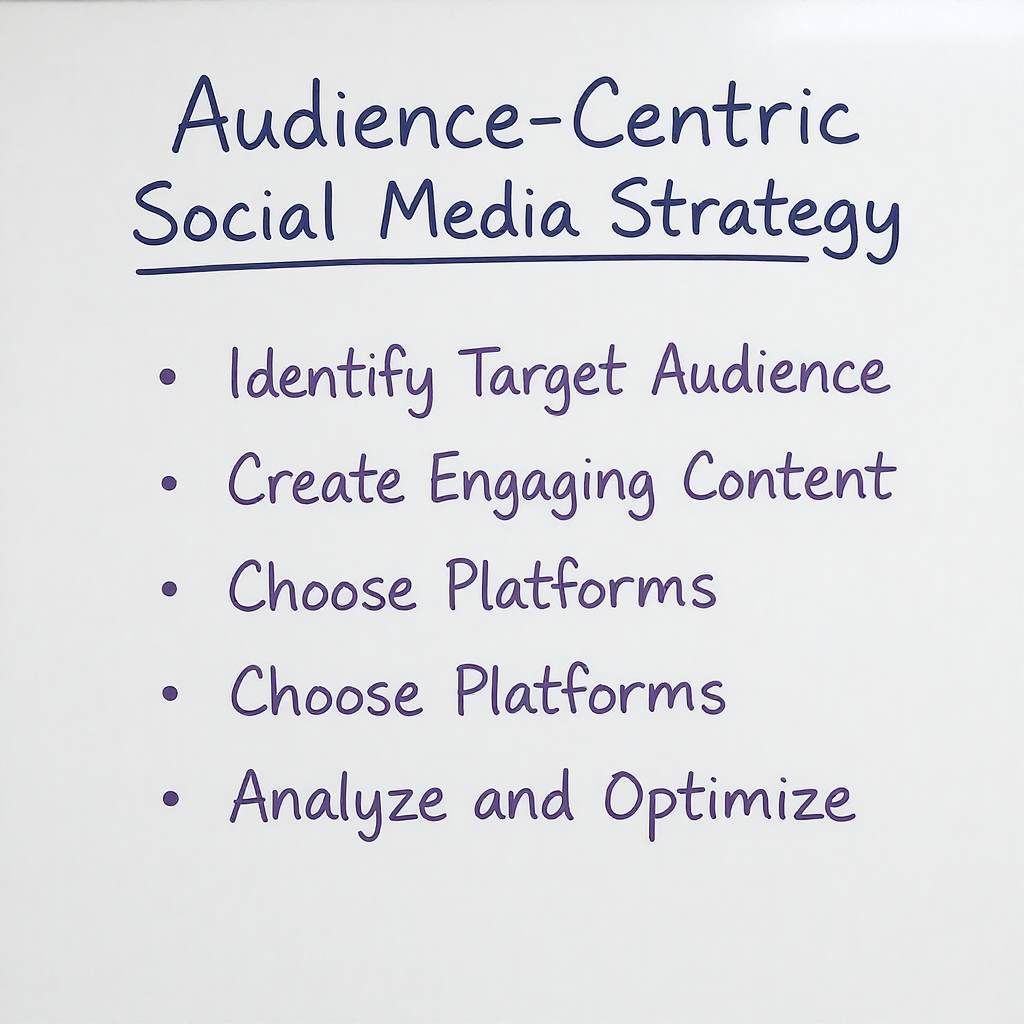In today’s digital landscape, building a strong presence on social media is more than just posting frequently or following trends. It’s about delivering meaningful content to the right people at the right time. Success starts with understanding your target audience deeply—who they are, what they care about, and how they behave online. Without this foundation, even the most creative content can fall flat.
Understanding your audience allows you to craft messages that resonate, drive engagement, and ultimately lead to conversions. It impacts everything from the tone of your content to the platforms you use and the way you spend your advertising budget. Let’s explore how identifying customer personas, conducting social media audits, and using analytics can help you understand your audience and elevate your social media strategy.
1. What Is a Target Audience and Why Does It Matter?
Your target audience is the specific group of people most likely to benefit from your products or services. They are the users you create content for, design campaigns around, and hope to attract. Knowing your audience ensures that your marketing efforts are intentional and not wasted on people who have no interest in your offerings.
When you understand your audience, you’re able to:
- Create content that resonates
- Boost engagement and reach
- Save money by targeting the right people in ads.
- Build trust and loyalty through relevance.
In social media, attention is short and competition is high. Relevance is your edge, and relevance starts with understanding.
2. Identifying Customer Personas: Know Who You’re Talking To
Customer personas are fictional, research-based profiles that represent your ideal audience segments. They help you understand not just who your customers are, but what motivates them, what problems they face, and how they prefer to engage.
A. Collect Demographic Data
Start with the basics:
- Age range
- Gender
- Location
- Occupation
- Education
- Income level
This information sets the groundwork for defining who your ideal customer is and how their needs may vary across regions or income levels.
B. Explore Psychographics
Go deeper by understanding:
- Hobbies and interests
- Personality traits
- Values and beliefs
- Pain points or challenges
- Media preferences (videos, blogs, memes, etc.)
This is where you learn what matters to your audience emotionally and mentally, which directly influences how they interact with content.
C. Define Their Goals
What are your audience’s short- and long-term goals? Are they seeking career growth, financial independence, health improvement, or entertainment? Knowing their aspirations lets you craft helpful, aspirational messaging.
D. Create and Name Personas
Example:
Name: Digital Daisy
Age: 28
Profession: Freelance designer
Platform: Instagram
Interests: Reels, behind-the-scenes content, productivity hacks
Goals: Build personal brand and find creative inspiration
Give your personas a name, a backstory, and even a photo if needed. This humanizes your strategy and makes targeting feel more intentional.
3. Conducting Social Media Audits: Researching Competitors and Trends

Now that you’ve defined your personas, you need to assess how your brand is performing and how your competitors are engaging with similar audiences. This is where a social media audit becomes crucial.
A. Review Your Own Performance
Analyze each platform you’re active on:
- Which posts perform best?
- What content types (carousel, reel, story) get the most traction?
- When is your audience most active?
- Are your visuals, captions, and hashtags aligned with your brand tone?
Understanding what’s working and what’s not helps you sharpen your approach.
B. Study Competitors’ Strategies
Pick 3–5 key competitors and examine:
- Content formats and topics
- Follower engagement
- Posting frequency and timing
- Brand voice and visual aesthetics
Take note of what resonates with their audience. Are there opportunities to stand out by doing something different?
C. Monitor Industry Trends
Stay up to date on:
- Trending hashtags
- Viral content formats
- Platform algorithm changes
- Audience behavior shifts
Use tools like Google Trends, Sprout Social, or Meta Business Suite to stay in the loop.
D. Conduct a SWOT Analysis
Use your findings to map out:
- Strengths: What you’re doing well
- Weaknesses: Where you’re underperforming
- Opportunities: Gaps in the market
- Threats: Competitor advantages or external risks
This sets the foundation for building a refined content strategy that directly addresses audience expectations.
4. Using Analytics to Gain Real Audience Insights
While personas and audits help guide your strategy, analytics tell you what’s actually happening in real time. They offer objective data to help refine your efforts.
A. Use Built-In Platform Insights
Most social platforms offer built-in analytics tools that provide valuable insights into your audience’s behavior. Instagram and Facebook offer data on reach, engagement, and demographics. LinkedIn shows job titles and industries. X (Twitter) provides impressions and interactions. These tools help you track performance, understand preferences, and refine your content strategy effectively.
- Instagram/Facebook: Track engagement, story views, reach, saves, and follower activity
- LinkedIn: See demographics, job titles, and company industries
- Twitter: View impressions, retweets, clicks, and audience interests
- Google Analytics: Track social traffic, bounce rates, and goal conversions on your site
B. Focus on Key Metrics
To measure audience understanding, pay attention to key metrics like engagement rate, reach, impressions, click-through rate, and follower growth. These indicators reveal how well your content connects with your audience, what captures their interest, and how effectively your posts drive action, guiding smarter and more tailored content strategies.
- Engagement rate: Are users interacting?
- Reach: How many unique users see your content?
- Impressions: How often is your content viewed?
- Click-through rate (CTR): Are users taking action?
- Follower growth: Is your audience expanding steadily?
- Conversion rate: Are followers turning into customers?
These insights help you adjust not just what you post but also when and how you deliver it.
C. Turn Data into Decisions
Let analytics guide your decisions by revealing what truly works. Use data to refine content formats, posting times, and engagement tactics. Adjust strategies based on target audience behavior, not assumptions. Smart use of insights ensures consistent improvement, helping you create more impactful content that resonates, performs, and converts across your social platforms.
- Post more of what performs well (e.g., reels over static images)
- Focus on peak activity times for posting.
- Build content themes around high-performing topics.
- Reallocate ad spend based on proven platform succes.s
The key is to not just collect data but to use it consistently to guide improvements.
5. Building an Audience-Centric Social Media Strategy

With your personas defined, your audit complete, and your analytics gathered, it’s time to connect the dots and build a content plan that speaks directly to your audience. Start by outlining your main audience segments and matching them with appropriate platforms, content styles, and messaging strategies. For instance:
- Persona: Business Bilal
- Platform: LinkedIn
- Content: Case studies, industry news, thought leadership
- Tone: Authoritative, professional
- Goal: Lead generation, B2B partnerships
Align your editorial calendar around these personas. Focus on topics that matter to them and time your posts when they’re most likely to engage. Every piece of content should aim to answer a question, solve a problem, or support a goal.
6. Mistakes to Avoid When Targeting Your Audience
Even with the right tools, brands often miss the mark by making these common errors. Having access to analytics, persona-building techniques, and audit frameworks is powerful—but only if used correctly. Misunderstanding or misapplying them can lead to wasted time, poor engagement, and missed opportunities. Let’s take a closer look at the most common mistakes brands make when trying to understand and connect with their target audience on social media:
- Guessing instead of researching: Never base personas or strategies on assumptions.
- Posting the same content everywhere: Different platforms require tailored approaches.
- Ignoring analytics: Data is your compass—check it regularly.
- Targeting everyone: When you try to appeal to all, you connect with none.
- Neglecting updates: Your audience evolves; so should your strategy.
Being aware of these mistakes will help you stay focused and avoid wasting time or resources.
7. Final Thoughts: Make Every Post Count
Understanding your target audience is not a task you check off once—it’s an ongoing process. As trends change and your business grows, so will your audience’s preferences. Continually update your personas, repeat your audits, and review your analytics to stay aligned with what your audience wants.
When you align your social media efforts with who your target audience truly is, you create content that’s not just seen, but remembered, shared, and acted on. And in a crowded digital space, that’s what builds loyalty, brand identity, and real growth.
